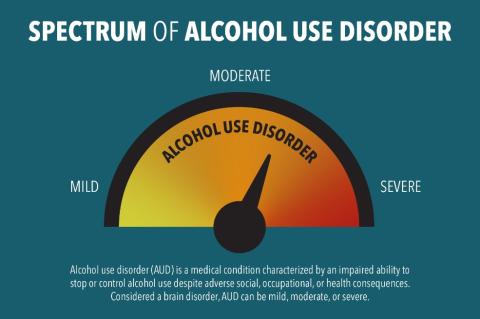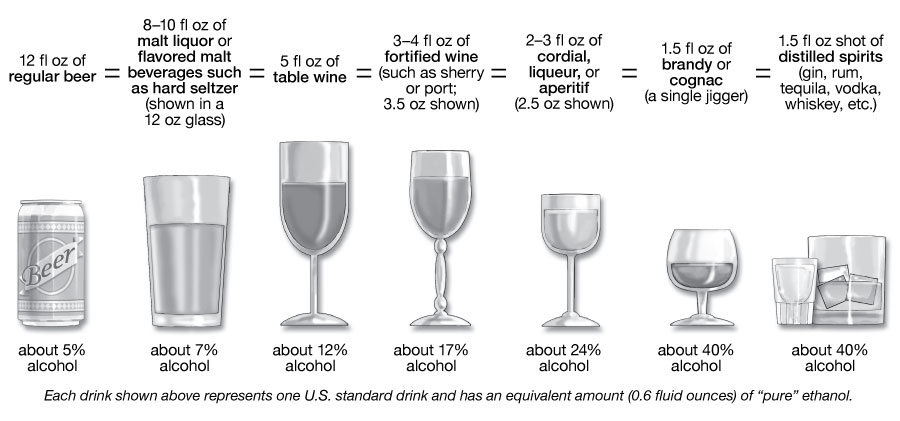We know alcohol use disorder (AUD), defined as “a pattern of alcohol use that involves problems controlling drinking, being preoccupied with alcohol, or continuing to use alcohol even when it causes problems” is prevalent in Missouri (1). In a 2019 Missouri Chamber of Commerce survey over 70% of employers stated alcohol use by employees affected the workplace.
Alcohol use is a socially acceptable use of substances, with a workplace norm to go out for drinks afterward, but a staggering number of individuals may have unknown substance use issues or unhealthy relationships with alcohol.
So how do we change our culture to provide supportive environments for individuals who may have alcohol use disorder (AUD)?
About AUD:
Alcohol use disorder is a disease affecting the mind and body. It’s important to recognize the signs, symptoms, and risk factors for developing or having AUD (2).

Signs/Symptoms of AUD
AUD ranges on a spectrum from mild to severe, depending on the number of symptoms you have.
Symptoms include:
- Spending a lot of time drinking or being ill from drinking
- Wanting to cut down on drinking but not being able to
- Wanting to drink so badly and being unable to think about anything else
- Giving up or cutting back on activities that were important or interesting to drink
- Having withdrawal symptoms like trouble sleeping, shakiness, restlessness, nausea, sweating, racing heart, or seizures
- Being aware that drinking or being ill from doing so intereferes with home, family, job, school, or other responsiblities
- Continuing drinking even though it has caused trouble with family or friends
- Continuing drinking despite it causing depressive or anxious feelings or causing other health problems, including blacking out
- Getting into situations after drinking which increased risk of getting hurt, like driving, swimming, operating machinery, or having unprotected sex
- Having to drink much more than previously to feel the effects, or that the “normal” amount consumed doesn’t have as much effect
The more symptoms present, the more severe the disorder. The symptoms can be present at any rate and in any combination (2).
Risk factors
Many factors contribute to increased risk for developing AUD. As with other substances, the use of alcohol early in life, before the brain is fully developed around the age of 25, increases the likelihood that individuals will become addicted to substances. Adverse Childhood Experiences (ACEs), and environment also play a role, as well as mental health conditions and genetics (2).
For a full list and to see symptoms and risk factors click here (2).
Things to think about with alcohol use:
Blood Alcohol Level
Alcohol stays in the system longer than we may realize. Our livers can only process alcohol at a rate of 0.015 g/ 100 mL/ hour –reducing blood alcohol concentration (BAC) by 0.015 per hour. So, if someone stayed up drinking until 2 AM and drove to work at 7 AM the next morning, it’s entirely possible they still have unmetabolized alcohol in their system and could be illegally driving and performing work duties. This becomes increasingly concerning for those working in an industry with machinery or required use of fine motor skills (3).
How alcohol is absorbed by our bodies
Alcohol absorption begins in the mouth, but predominately happens in the lining of the stomach and first part of the small intestine (4).
Certain factors affect the rate of absorption in our bodies:
- Food: If you have food in your stomach before consuming alcohol, it slows the rate of alcohol absorption
- Body composition: Alcohol is absorbed into every body tissue except bone and adipose (fat). A person with a higher percentage of body fat will have a more rapid increase in BAC, as the alcohol will be more concentrated in their muscle cells.
- Rate of ingestion: The more quickly alcohol is consumed, the more quickly the effect will be present
- Mood: Being depressed or anxious before consuming alcohol can heighten its effects
- Functional Tolerance
- Medications: Some medications can speed up or slow down rates of absorption or heighten alcohol’s effects
- Fatigue: Being fatigued can heighten alcohol’s effects
- Illness: Being ill can increase alcohol’s effects
- Gender: Generally, women and trans women see greater effects from alcohol
- Type and amount of alcohol
(4)
Tolerance
Functional tolerance or “tolerance,” known as how much someone is affected by alcohol or “how well someone handles their liquor” does not have any indicator of blood alcohol content (BAC). Someone can appear to be sober, but their body still has the same digestion rate and should follow guidelines for alcohol consumption rate below.
Check out the link to see effects of alcohol with a timeline of absorption, see here (3):
What is one drink?
Alcoholic drinks look different based on the type of alcohol and the container. See the image below to see different standard drink equivalents (5).

Alcohol affects genders differently
Women have less percent body water than men, so have a higher concentration of alcohol in the blood after drinking, resulting in a higher immediate effect from the alcohol. They also have less dehydrogenase in their stomachs, an enzyme that breaks down alcohol before it gets to the liver, which means all the alcohol they consume must be broken down in the liver.
Women eliminate alcohol from the blood at a faster rate than men.
Hormones affect the rate of absorption. Alcohol has more severe effects on women closer to when they’re menstruating, as hormones are peaking (6). Peri or postmenopausal women on hormone replacement therapy may see varying effects from alcohol consumption as well (7).
For trans individuals who may be on hormone treatment, the increased estrogen effects on metabolization rate should be considered, as they could result in a higher spike in BAC (8).
How to support individuals with AUD:
When it comes to work or other social functions, trying to have events in a neutral space without alcohol or with non-alcoholic options might be a good decision. Individuals with alcohol use disorder will likely feel more welcome if the focal point isn’t around drinking.
We also know employers reaching out to individuals with AUD or another substance use disorder have a greater impact on those people seeking recovery –even more so than family! Having some form of support within the workplace, like an FMLA program, destigmatizing language and work environment, and offering spaces or time off for individuals to attend meetings or appointments to support their recovery are a few ways to support individuals in the workplace.
References
- Mayo Clinic. Alcohol Use Disorder. Accessed April 2023. https://www.mayoclinic.org/diseases-conditions/alcohol-use-disorder/symptoms-causes/syc-20369243.
- National Institute of Alcohol Abuse and Alcoholism. Understanding Alcohol Use Disorder. Accessed April 2021. https://www.niaaa.nih.gov/publications/brochures-and-fact-sheets/understanding-alcohol-use-disorder.
- Bowling Green State University. Alcohol Metabolism. Accessed April 2023. https://www.bgsu.edu/recwell/wellness-connection/alcohol-education/alcohol-metabolism.html.
- Ramapo College of New Jersey. Absorption Rate Factors. Accessed April 2023. https://www.ramapo.edu/aod/absorption-rate-factors/
- National Institute of Alcohol Abuse and Alcoholism. What is a Standard Drink? Accessed April 2023. https://www.niaaa.nih.gov/alcohols-effects-health/overview-alcohol-consumption/what-standard-drink.
- University of Notre Dame. Student Well-Being McDonald Center. Absorption Rate Factors. Accessed April 2023. https://mcwell.nd.edu/your-well-being/physical-well-being/alcohol/absorption-rate-factors/.
- Miller, Leah. Drinking Alcohol During HRT. American Addiction Centers. Accessed April 2023. https://alcohol.org/health-effects/hrt-and-alcohol/#.
- Cornell Health. (18, October 2019). Why Biology Matters When it Comes to Drinking Alcohol. Accessed April 2023. https://health.cornell.edu/sites/health/files/pdf-library/Why-Biology-Matters-Drinking.pdf.

